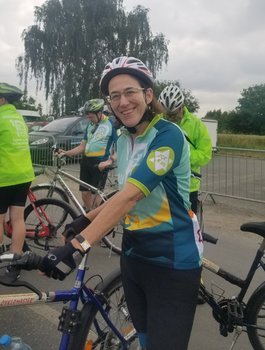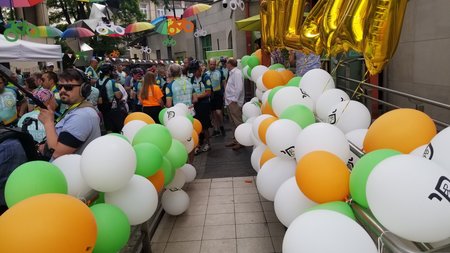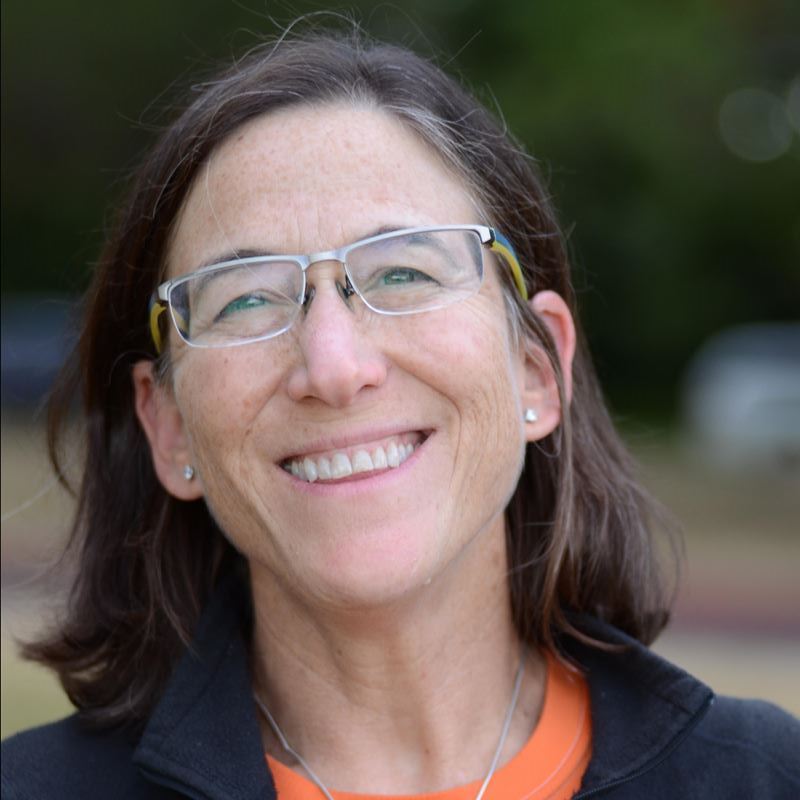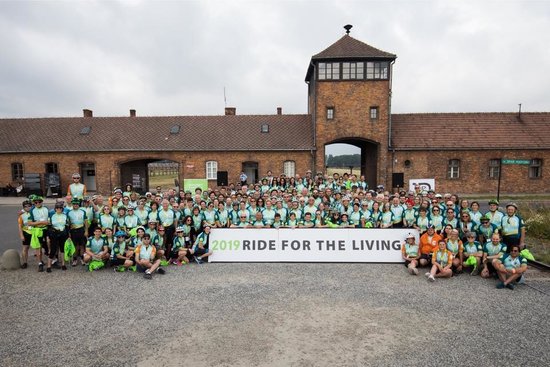Bernard Offen, a spry 90-year-old, pony-tailed, Auschwitz/Birkenau survivor, stood under the burning sun and described how, as a boy, he watched his father walk down the long path toward the gas chamber and crematoria #5. It was outside the ruins of crematoria #5 that Bernard told a bit of his story. My heart broke as Kel Maleh Rachamim was chanted together and we recited the Kaddish.
By the next morning Bernard and the rest of us (250 in total) were back at the iconic gate of Birkenau. But this time, we had bikes and helmets. Our goal was to ride 60 miles from the gates of Birkenau to the gate of the JCC in Krakow. The intention of the ride was to commemorate and memorialize the murdered Jews of Europe and to celebrate the fact that we are still here – free to ride away from this place in a group of proud Jews. Bernard rode a tandem bike with Jonathan Ornstein, the Executive Director of the 11-year-old Krakow JCC. I think they just rode the first 14 of the 60 miles, but that if I can do that when I am 90, I’ll be pleased.
We started biking slowly, all bunched together with a police escort due to the traffic on the roads surrounding Auschwitz/Birkenau. I was frustrated, as I wanted to go faster, but I used the opportunity to meet some of my fellow riders.
 After the first 13 miles, there was a rest stop. There was a camera set up for people to be interviewed, as the JCC is creating a film about the renewal of life in Krakow and the Ride for the Living. I noticed that a young boy was being interviewed and went over to hear what he was saying. He was the youngest rider at nine-years old and like the oldest – Bernard – he rode the first 14 miles and then was heading back to Krakow by car. He had heard his parents discussing the “big bike ride in Poland” and he told them that he did not want to be left out. So, he came with his parents and grandparents, who at the time of the interview, were not present.
After the first 13 miles, there was a rest stop. There was a camera set up for people to be interviewed, as the JCC is creating a film about the renewal of life in Krakow and the Ride for the Living. I noticed that a young boy was being interviewed and went over to hear what he was saying. He was the youngest rider at nine-years old and like the oldest – Bernard – he rode the first 14 miles and then was heading back to Krakow by car. He had heard his parents discussing the “big bike ride in Poland” and he told them that he did not want to be left out. So, he came with his parents and grandparents, who at the time of the interview, were not present. 
“What would you say to other nine-year-old kids about why they should learn about the Holocaust,” the interviewer asked. “Nine-year-old kids should learn about the Holocaust so that they know that life is not always happy,” he answered, “but they should know that life is not always sad.”
I was blown away by his answer. A man came and stood next to me as I was watching this unfold and I turned to him and said, “listen to this kid – he is amazing.” The man said, “that’s my boy!” I slapped him on the back and said, “well done.” This young man’s wisdom about life goes well beyond his nine years and was just a snapshot of the meaningful things that were discussed and said on this life-enriching ride.
We were set loose to bike at our own speed for the next 36 miles. There was a speedster group in the front who traveled about 20 miles per hour, too fast for me, but I was faster than the slowest group that gathered in the back. Consequently, I rode for hours by myself through the Polish countryside, meeting some riders here and there, talking for a bit and then moving on. It gave me plenty of time to assess my complicated feelings about Poland. Every farm I passed (and there were many), I thought of my father-in-law Sam’s family farm in Bagatele. Every small town I passed through, I thought of my mother-in-law Esther’s small Shtetl of Stoczek. I wondered what these families did or more likely did not do to help Jews during the war, so close to Auschwitz. The towns nearby could smell the flesh burning, day after day. But the countryside is so peaceful and bucolic. Some of the locals came out of their houses to gawk at the group of riders passing by. Did they know we were a group of Jews riding from Birkenau to Krakow? I don’t know. But I wondered, if they knew, what they would think?
I was deeply moved to meet many of the non-Jewish Poles who volunteered for the ride, as marshals riding along with us, as helpers at the rest stops, as people who put our welcome bags together, greeting us with a smile as we reached the Krakow JCC and then again that evening as we joined for a 600-person Shabbat dinner in the middle of Kazimierz – the old Jewish Quarter of Krakow. The non-Jewish Poles that I met were so happy to be involved with this ride and to meet us and discuss what is going on in Krakow and how they want to help rebuild the Jewish life there, their tiny bit of tikkun.

 I met some great characters on the ride. Jeff and Sean, a grandfather/grandson team from the Boston area, both so sweet and so happy to be doing this together. Then I met a New Yorker who married a woman who grew up in Krakow and only discovered that her grandmother was Jewish as a young woman and was welcomed at the JCC to learn about what it means to live as a Jew. And then there was Rabbi Steve Moss, the Rabbi of B'nai Israel Reform Temple in Oakdale who gave a dvar torah at the small kiddish for the “locals” at the Old Izaak’s Synagogue on Shabbat morning. I suppose it is a self-selecting group of really interesting people who go to Poland to ride 60 miles from Auschwitz to Krakow!
I met some great characters on the ride. Jeff and Sean, a grandfather/grandson team from the Boston area, both so sweet and so happy to be doing this together. Then I met a New Yorker who married a woman who grew up in Krakow and only discovered that her grandmother was Jewish as a young woman and was welcomed at the JCC to learn about what it means to live as a Jew. And then there was Rabbi Steve Moss, the Rabbi of B'nai Israel Reform Temple in Oakdale who gave a dvar torah at the small kiddish for the “locals” at the Old Izaak’s Synagogue on Shabbat morning. I suppose it is a self-selecting group of really interesting people who go to Poland to ride 60 miles from Auschwitz to Krakow!
We were given biking shirts and another quick-dry t-shirt. The design on both included a yellow star. At first this seemed disconcerting – to put this symbol of discrimination and death on shirts to wear biking or around town. But my discomfort was put to rest by another 90-year-old Holocaust survivor who was there to share her mother’s art. On Shabbat evening, there was an opening of a small art exhibit of work done by Sofia Guttentag-Davidson. Sofia is no longer alive, but her daughter, who survived labor and concentration camps with her, was present with her own children and grandchildren. The daughter, who is a tiny, white-haired, soft-spoken woman, began to speak and I could see that she was overwhelmed with emotion to be back in Poland and to bring her mother’s artwork, painted after the war, to Krakow.
She spoke, in a hushed room, of being a child with a yellow star on her clothing and how the Nazis had ordered that no Jews could cross any major street. So, to get to school, she had to walk all the way around the town. One day she said to her friend: “I don’t understand, last week it was fine for us to just cross this street and go home from school, but now we are not allowed. I am tired and I just want to go home. Let’s cross the street and go home.” These two Jewish girls, with yellow stars as bulls-eyes on their jackets, began to cross the street. All of the sudden they heard someone shout,“Nazis!” Then they heard gunshots – the Nazis were shooting at them because they were Jews crossing a major street, which was against “the law.” They began to run, but her friend was hit and fell to the ground dead. She kept running and made it home.
“I noticed,” she continued, “that yesterday, the riders had a yellow star on their shirts. At first, I was shocked, but my shock turned to happiness because I realized that these people wearing yellow stars are free Jews and are the future of the Jewish people. My grandchildren are here with me; they are my future; they are our future.”
That sums it up – let’s commemorate the past but celebrate the future.

Get To Know The Author
Wexner Heritage Alum Karen Treiger (Seattle) is the author of My Soul is Filled with Joy: A Holocaust Story, and lives in Seattle, WA.

